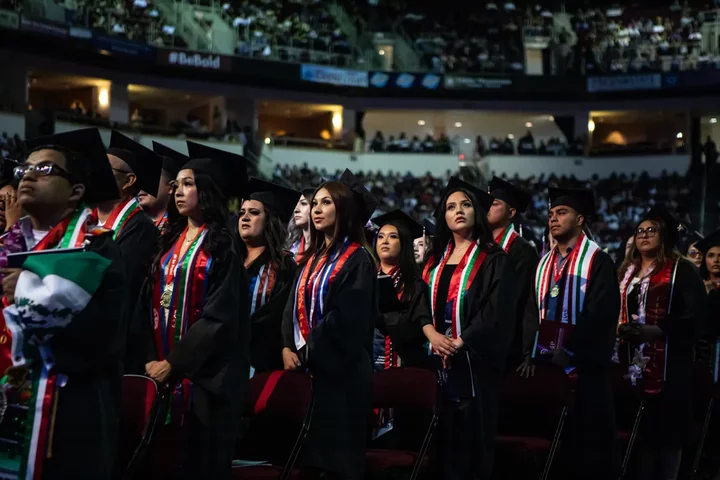Graduating students take their seats at the Fresno State Chicano/Latino Commencement Celebration in the Save Mart Center in Fresno on May 18, 2024. Photo by Larry Valenzuela, CalMatters/CatchLight Local
California State University is only partially meeting its bold plan to graduate 40% of its students who started as freshmen by the end of four years. In newly released data this week, the system saw its four-year graduation rate inch to an all-time high of 36.2% this year — more than double the graduation rate it posted in 2013.
The system has one year left to make good on its Graduation Initiative 2025 goals, which it debuted in 2015. The splashy effort was buttressed by a combination of system and state funding increases that over time reached $400 million annually. That money has gone toward hiring more professors, opening more classes in courses with high waitlists that students need to graduate, cutting the number of students finishing classes with Ds and Fs and reaching out to students who dropped out.
The growth in graduation rates overlapped with a 31% spike in freshmen enrollment between 2009 and 2019, meaning the system’s graduation rate increased even as it was absorbing an additional 15,000 students.
The type of students Cal State enrolled changed as well, explained Jennifer Baszile, an associate vice chancellor for the system, at the board of trustees meeting Wednesday. In that same period, the university saw a 50% jump in freshmen who were the first in their families to attend college, come from low-income households or identify as Black, Latino or Native American — all groups that campuses have historically struggled to graduate at rates similar to other students.
“We are opening up opportunities for students who traditionally have not had them,” said Diego Arambula, vice chair of the board of trustees, at Wednesday’s meeting.
Among transfer students, the system is even closer to its 2025 goals, having graduated 44% of students within two years who came from community colleges — just shy of the 45% target it set for itself. Graduation rates are calculated separately for students who start as freshmen and those who transfer. Lately, about 40% of Cal State’s new students are transferring from other schools.
Gaps remain between racial and ethnic groups
But for the system’s other core goals to eliminate the differences in graduation rates between Black, Latino, Native American and all other students, the gaps remain recalcitrant.
The six-year graduation rate for Latino students, the system’s largest racial or demographic group, dipped from a high of 58% in 2021 to 56% in 2024 — well short of the 2025 goal to have 70% of all students who started as freshmen graduate within six years but higher than the 52% in 2015.
White and Asian students as distinct groups reached or surpassed the 70% goal by 2020.While the traditional timeline for earning a bachelor’s degree is four years, the six-year graduation rate is a common metric that reflects the modern realities for many students: They work to afford their education and care for families, activities that require them to enroll in a reduced number of courses, which means they take longer to graduate.
For Black students, the graduation rate remains stubbornly low — at no point has Cal State graduated more than 50% of Black students at the end of six years who started as freshmen. At spring’s end this year, the rate stood at 49 percent — a full 21 percentage points below the 70% goal.
Cal State is the nation’s largest public four-year university system and is home to more than 400,000 undergraduates.Another immovable gap is the one between students receiving federal Pell grants because they come from low-income families and those who don’t.
At Cal State, nearly half of students receive this benefit and they graduate at rates 10 to 12 percentage points below those of students from families with higher incomes. The gulf between students with and without Pell grants is supposed to close completely by next year under the goals Cal State set forth.
“Closing equity gaps is really, really hard,” said Christopher J. Steinhauser, a trustee who was superintendent of the Long Beach public k-12 school system, among the state’s largest. “Sometimes when you have initiatives and people do better, the gaps actually grow, and we actually have seen that here in our own system.”
Covid’s impact
One force constraining graduation rates is the effect the COVID-19 pandemic had on students remaining in school. A key early measure of whether students will graduate is how many return after their first and second years of school. At Cal State, that so-called retention figure gradually grew until the pandemic struck. Among students who started as freshmen in 2019, about 85% returned after their first year. But for those who started in 2020, the year Covid devastated the world’s public health systems and plunged many families into financial distress, the share of returning students dropped to 83% and the next year to 81%.
Once students leave, it’s difficult to persuade them to return, higher-education experts say.
Still, Cal State has a higher overall graduation rate than most other similar universities in other states. The University of California, which rejects far more applicants than Cal State, graduates about 72% of its freshmen within four years — double that of Cal State.
###
CalMatters.org is a nonprofit, nonpartisan media venture explaining California policies and politics.

CLICK TO MANAGE